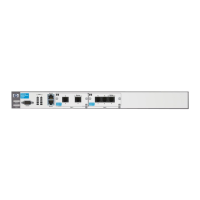2-44
Controlling Management Access to the ProCurve Secure Router
Using SNMP to Manage the ProCurve Secure Router
Using SNMP to Manage the ProCurve
Secure Router
SNMP is an industry-standard protocol that allows you to manage and monitor
a variety of network devices from a central location. Specifically, you can
configure these SNMP-compliant devices and apply consistent security and
management policies to these devices across your network.
You can also monitor SNMP-compliant devices for conditions requiring admin-
istrative attention—for example, a server has gone down, a printer is jammed,
or a WAN connection is no longer available. You can track device uptime, link
states, and many other device information variables. When a problem occurs,
SNMP-compliant devices send an alert message to one or more designated
SNMP servers, and you can then take steps to resolve the problem.
SNMP Architecture
SNMP works in a client-server relationship: SNMP agents, which function as
clients, run on managed devices, and the SNMP server is a management
application that requests, handles, and analyzes the information from the
managed devices. Typically, you access the SNMP server from an SNMP
console, or application.
SNMP is considered “simple” because the SNMP agent and the SNMP server
use only five basic commands to communicate. However, the SNMP architec-
ture is actually somewhat complicated.
In the SNMP architecture, managed devices such as the ProCurve Secure
Router are represented and stored as network objects in a management
information base (MIB); the objects are identified in a hierarchical name space
containing object identifier (OID) numbers. Within the MIB, network objects
can organized into views; the views, in turn, can be assigned to SNMP groups.
Group members can then monitor the objects within the view. (See Figure 2-8.)

